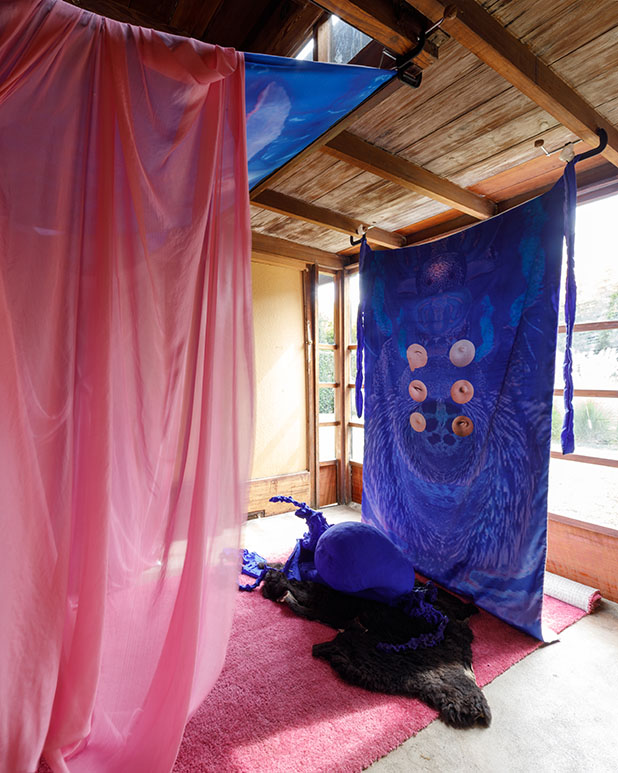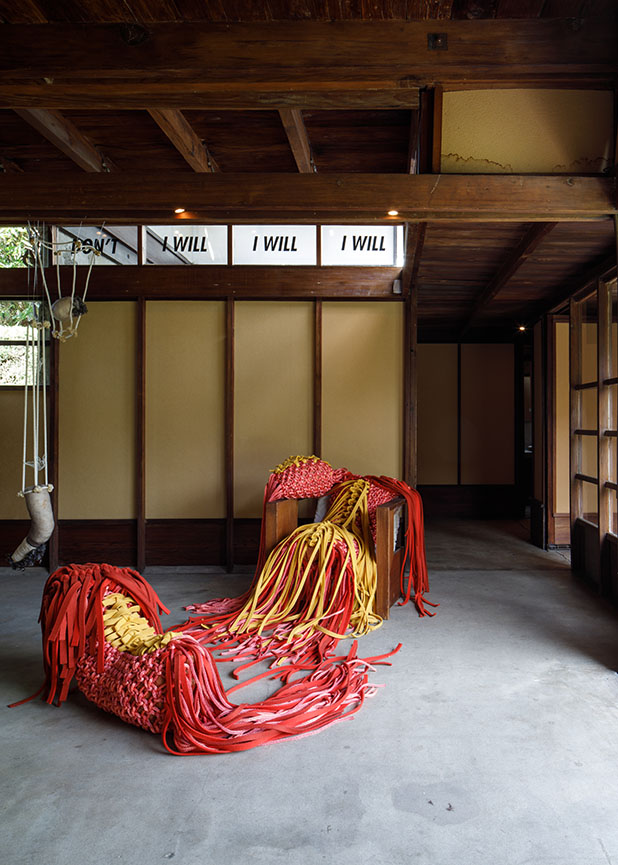Even in a white cube, there is always an element of architectural engagement to grapple with when laying out out an exhibition. But when the exhibition space is not a white cube — and moreover, when the venue itself is a storied architectural landmark, such as the Schindler House — this navigation can take the form of an outright intervention. Furthermore, the way Mimi Ziegler curated the thoughtful and eccentric group show Soft Schindler, the formal and material interventions with the site mitigate not only its physicality but its historical zeitgeist as well.
Throughout the rooms and occasionally the grounds, sculptural, video, and mixed media works operate in a manner counter to the modernist conventions the building asserts, approaching outright irreverence for its spatial manifesto. But the various forms of “soft” confrontations are not destructive, but rather complexifying and accretive, seeking less to undermine than to augment or reframe the machismo of the modernist hero with a more empathetic experiential dimension. A running clerestory installation of text by Design Bitches reads in snippets like “Don’t I Will” and “You Touch Me” in both a rejection and a generator of site-specific shadow-casting that embraces the building’s light-lines and bridges the outdoors with the interior — as intended by the architect, and yet not at all as he intended.

Sonja Gerdes, Pie of Trouble. Stays Trouble. Belly on Belly. Let’s Hang. Breathe you infinite. Animal Creature Plant Breath Soul. The Energy Plan. Amorphous Hypersensibility. Do Spiders Breathe? Mothersmilk. The Multiple Amorphous Us. Air For Free., 2019. Photo © Taiyo Watanabe, courtesy of the MAK Center for Art and Architecture.
Certain sculptural works — Bettina Hubby’s chic and cozy photo-printed and hand-embroidered pillow pile The Response to a Hard Edge; Bryony Roberts’ Felty, a tactile, tentacled sprawl of felt and rope resembling a disemboweled easy chair — directly reference an understanding of domestic furniture. Alice Lang’s coiled and partially deconstructed ceramic figures reference art historical tropes of classical male beauty subjected to entropy and assertions of gender fluidity; they occupy space like rarefied artifacts but emote with visceral poetry. Tanya Aguiñiga’s bulbous abstract forms hang from the rafters filling mid-air space; their organic, biomorphic bodies are lowkey grotesque and their intention to discomfit is made clear in their titles: Omission, Privilege, Structures of Oppression.
In the home’s back room, an inscrutable, translucent, diaphanous but ultimately impenetrable maze of coffee- and tobacco-dyed cotton curtains protect and obscure the promise of a secret inner space, referencing the once-lively social life of the house. The Garden of Earthly Delights by Agenda Agencia de Arquitectura is perhaps the most literal example of “softening” the architecture itself, as well as one of the quietest experiences. By contrast, the loudest is the two-channel video installation Choreographies by Pedro Alonso and Hugo Palmarola which pairs a montage of vintage animations about construction and engineering with a carnivalesque soundtrack by Nortec Collective. Its juxtapositions range from the avant-garde to the slapstick and cartoonish and its cheerful, slightly obnoxious soundtrack permeates the house with a tone of casual, well-meaning subversion in a pointed challenge to its sacrosanct status.


